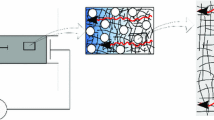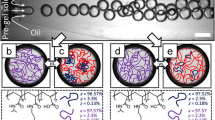Abstract
Determination of effective transport properties of droplet-hydrogel composites is essential for various applications. The transport of ions through a droplet-hydrogel composite subjected to an electric field is theoretically studied as an initial step toward quantifying the effective transport properties of droplet-hydrogel composites. A three-phase electrokinetic model is used to derive the microscale characteristics of the polyelectrolyte hydrogel, and the droplet is considered an incompressible Newtonian fluid. The droplet-hydrogel interface is modeled as a surface, which encloses the interior fluid. The surface has the thickness of zero and the electrostatic potential ζ. Standard averaging procedures are used to derive the effective governing equation for the current density that captures the macroscopic behavior. The results show that the polymer boundary condition has a modulating impact on the electrical conductivity, and the influence of the boundary condition decreases as the interior fluid viscosity increases. At the limit of the polymer’s no-slip boundary condition, the interior and exterior fluids’ viscosities, Brinkman screening length, and ionic strength have a significant impact on the conductivity. Interestingly, it should be possible to determine the ζ-potential for a droplet-hydrogel composite from measurements of the electrical conductivity with the aid of the formula derived for the conductivity. Finally, the theoretical study for determining the response of droplet-hydrogel composites to an imposed pressure gradient is undertaken, and it is found that the polymer boundary condition has a modulating impact on the response.










Similar content being viewed by others
References
Kremmer T, Boross L (1979) Gel chromatography: theory, methodology, applications Wiley-Interscience publication. Wiley
Osada Y, Gong JP, Tanaka Y (2004) Polymer gels. J Macromol Sci, Polym Rev 44(1):87–112
Ferry JD (1980) Viscoelastic properties of polymers, 3rd edn. Wiley, New York
Qiu Y, Park K (2001) Environment-sensitive hydrogels for drug delivery. Adv Drug Deliver Rev 53(3):321–339
Brandl F, Sommer F, Goepferich A (2007) Rational design of hydrogels for tissue engineering: impact of physical factors on cell behavior. Biomaterials 28:134–146
Bar-Cohen Y (2007) Electroactive polymers as an enabling materials technology. Proc IMechE Part G: J Aerospace Eng 221:553–564
Calvert P (2004) Electroactive polymer (EAP) actuators as artificial muscles—reality, potential and challenges chapter 5 2nd edition. SPIE Press, Bellingham, pp 151–170
Eddington DT, Beebe DJ (2004) Flow control with hydrogels. Adv Drug Delivery Rev 56(2):199–210
Kim D, Beebe DJ (2007) Hydrogel-based reconfigurable components for microfluidic devices. Lab Chip 7(2):193–198
Dhopeshwarkar R, Sun L, Crooks RM (2005) Electrokinetic concentration enrichment within a microfluidic microplug, device using a hydrogel. Lab Chip 5:1148–1154
Beebe DJ, Moore JS, Bauer JM, Yu Q, Liu RH, Devadoss C, Jo B-H (2000) Functional hydrogel structures for autonomous flow control inside microfluidic channels. Nature 404(2):588– 590
Matos MA, White LA , Tilton RD (2006) Electroosmotically enhanced mass transfer through polyacrylamide gels. J Colloid Interface Sci 300:429–436
Matos MA, White LR, Tilton RD (2008) Enhanced mixing in polyacrylamide gels containing embedded silica pumps, nanoparticles as internal electroosmotic. Colloid Surf B Biointerf 61(2):262–269
Huang G, Zhang X, Xiao Z, Zhang Q, Zhou J, Xu F, Lu TJ (2012) Cell-encapsulating microfluidic stability, hydrogels with enhanced mechanical. Soft Matter 8:10687–10694
Komarova GA, Starodubtsev SG, Lozinsky VV, Nasimova IR, Khokhlov AR (2013) Intelligent gels and cryogels with embedded emulsions of various oils. J Appl Polym Sci 127(4):2703– 2709
Sala G, van Vliet T, Cohen Stuart MA, van Aken GA, van de Velde F (2009) Deformation and fracture of emulsion-filled gels: effect of oil content and deformation speed. Food Hydrocolloid 23(5):1381–1393
Shingel K, Roberge C, Zabeida O, Robert M, Klemberg-Sapieha JE (2009) Solid emulsion gel as a novel construct for topical applications: synthesis, morphology and mechanical properties. J Mater Sci - Mater Med 20:681–689
Sala G, van Aken GA, Stuart MAC, van de Velde F (2007) Effect of droplet-matrix interactions on large deformation properties of emulsion-filled gels. J Texture Stud 38(4):511–535
Chojnicka A, Sala G, de Kruif CG, van de Velde F (2009) The interactions between oil droplets and gel matrix affect the lubrication properties of sheared emulsion-filled gels. Food Hydrocolloid 23(3):1038–1046
Mohammadi A (2013) Electric-field-induced response of a droplet embedded in a polyelectrolyte gel. Phys Fluids 25(8):082004
Mohammadi A (2014) Electrokinetic mixing and displacement of charged droplets in hydrogels. Trans Porous Med 104(3):469– 499
Mizuno D, Kimura Y, Hayakawa R (2001) Electrophoretic microrheology in a dilute lamellar phase of a nonionic surfactant. Phys Rev Lett 87 (8):088104
Mohammadi A (2011) Dynamics of colloidal inclusions in hydrogels. Ph.D. thesis, chapter 5, McGill university
Bradshaw-Hajek BH, Miklavcic SJ, White LR (2008) Frequency-dependent electrical conductivity of concentrated dispersions of spherical colloidal particles. Langmuir 24(9):4512– 4522
Bordi F, Cametti C, Chen SH, Rouch J, Sciortino F, Tartaglia P (1996) The static electrical conductivity of water-in-oil microemulsions below percolation threshold. Physica A 231(1–3):161–167
Zhao H, Zhai S (2013) The influence of dielectric decrement on electrokinetics. J Fluid Mech 724:69–94. 6
Stout RF, Khair AS (2014) A continuum approach to predicting electrophoretic mobility reversals. J Fluid Mech 752(8)
Kosto KB, Deen WM (2004) Diffusivities of macromolecules in composite hydrogels. AIChE J 50(11):2648–2658
Amsden B (2001) Diffusion in polyelectrolyte hydrogels: application of an obstruction-scaling model to solute diffusion in calcium alginate. Macromolecules 34(5):1430–1435
Bandopadhyay A, Hossain SS, Chakraborty S (2014) Ionic size dependent electroviscous effects in ion-selective nanopores. Langmuir 30(24):7251–7258
Darwish MIM, van der Maarel JRC, Zitha PLJ (2004) Ionic transport in polyelectrolyte gels: model and nmr investigations. Macromolecules 37(6):2307–2312
O’Brien RW (1981) The electrical conductivity of a dilute suspension of charged particles. J Colloid Interface Sci 81(1):234–248
Cox RG (1969) The deformation of a drop in a general time-dependent fluid flow. J Fluid Mech 37:601–623
Gary Leal L (2007) Advanced transport phenomena: fluid mechanics and convective transport processes. Cambridge University Press, New York
O’Brien RW, White LR (1978) Electrophoretic mobility of a spherical colloidal particle. J Chem Soc, Faraday Trans 2 74:1607–1626
Mangelsdorf CS, White LR (1993) Low-zeta-potential analytic solution for the electrophoretic mobility of a spherical colloidal particle in an oscillating electric field. J Colloid Interface Sci 160(2):275–287
Ohshima H, Healy TW, White LR (1984) Approximate analytic expressions for the electrophoretic mobility of spherical colloidal particles and the conductivity of their dilute suspensions. J Chem Soc Faraday Trans 2 80:1643
Abramowitz M, Stegun IA (1972) Handbook of mathematical functions. Dover, New York
Sasaki S (2006) Elastic properties of swollen polyelectrolyte gels in aqueous salt solutions. J Chem Phys 124:094903
Sasaki SH, Ojima H, Yataki K, Maeda H (1995) Flory exponent of the chain of the expanding polyion gel. J Chem Phys 102(24):9694–9699
Gundogan N, Melekaslan D, Okay O (2002) Rubber elasticity of poly(n-isopropylacrylamide) gels at various charge densities. Macromolecules 35:5616–5622
Okay O, Durmaz S (2002) Charge density dependence of elastic modulus of strong polyelectrolyte hydrogels. Polymer 43:1215–1221
Raphael E (1990) Annealed and quenched polyelectrolytes. Europhys Lett 13(7):623–628
Guo X, Ballauff M (2001) Spherical polyelectrolyte brushes: Comparison between annealed and quenched brushes. Phys Rev E 64(5):051406
Fiumefreddo A, Utz M (2010) Bulk streaming potential in poly(acrylic acid)/poly(acrylamide) hydrogels. Macromolecules 6(6):2401–2420
DeLacey EHB, White LR (1981) Dielectric response and conductivity of dilute suspensions of colloidal particles. J Chem Soc, Faraday Trans 2 77(11):2007–2039
Ahualli S, Delgado A, Miklavcic SJ, White LR (2006) Dynamic electrophoretic mobility of concentrated dispersions of spherical colloidal particles. on the consistent use of the cell model. Langmuir 22(16):7041–7051
Bradshaw-Hajek BH, Miklavcic SJ, White LR (2010) High-frequency behavior of the dynamic mobility and dielectric response of concentrated colloidal dispersions. Langmuir 26(3):1656–1665
Bradshaw-Hajek BH, Miklavcic SJ, White LR (2010) The actual dielectric response function for a colloidal suspension of spherical particles. Langmuir 26(11):7875–7884
O’Brien RW, Perrins WT (1984) The electrical conductivity of a porous plug. J Colloid Interface Sci 99(1):20–31
Looker JR, Carnie SL (2006) Homogenization of the ionic transport equations in periodic porous media. Trans Porous Med 65:107–131
Simhadri JJ, Stretz HA, Oyanader M, Arce PE (2010) Role of nanocomposite hydrogel morphology in the electrophoretic separation of biomolecules: a review. Ind Eng Chem Res 49(23):11866–11877
Russel WB, Schowalter WR, Saville DA (1989) Colloidal dispersions. Cambridge University Press, Cambridge
Lin KL, Osseo-Asare K (1984) Electrophoretic mobility of oil drops in the presence of solvent extraction reagents. Solvent Extr Ion Exch 2(3):365–380
Beaman DK, Robertson EJ, Richmond GL (2012) Ordered polyelectrolyte assembly at the oil-water interface. Proc Natl Acad Sci 109(9):3226–3231
Leunissen ME, van Blaaderen A, Hollingsworth AD, Sullivan MT, Chaikin PM (2007) Electrostatics at the oil-water interface, stability, and order in emulsions and colloids. Proc Natl Acad Sci 104(8):2585–2590
Bhosale PS, Chun J, Berg JC (2011) Electroacoustics of particles dispersed in polymer gel. Langmuir 27(12):7376–7379
Bhosale PS, Berg JC (2010) Acoustic spectroscopy of colloids dispersed in a polymer gel system. Langmuir 26(18):14423–14426
Xie G, Okada T (1995) Water transport behavior in nafion 117 membranes. J Electrochem Soc 142(9):3057–3062
Acknowledgment
The author would like to appreciate the Sharif university of technology research council for the financial support.
Author information
Authors and Affiliations
Corresponding author
Rights and permissions
About this article
Cite this article
Mohammadi, A. Transport in droplet-hydrogel composites: response to external stimuli. Colloid Polym Sci 293, 941–962 (2015). https://doi.org/10.1007/s00396-014-3473-8
Received:
Revised:
Accepted:
Published:
Issue Date:
DOI: https://doi.org/10.1007/s00396-014-3473-8




